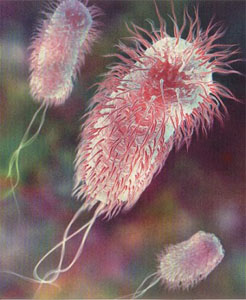Triclosan: Resistance
 Manufacturers claim that the use of antibacterial-containing products would protect your health and that of your family. However, there is substantial evidence that the widespread use of antibacterial compounds, such as Triclosan and Triclosan-containing products, promote the emergence of bacteria resistant to antibiotic medications and antibacterial cleansers.
Manufacturers claim that the use of antibacterial-containing products would protect your health and that of your family. However, there is substantial evidence that the widespread use of antibacterial compounds, such as Triclosan and Triclosan-containing products, promote the emergence of bacteria resistant to antibiotic medications and antibacterial cleansers.
This means that the use of these household products may actually contribute to more illnesses. Antibacterial compounds do not eliminate all germs or bacteria they encounter. Those that survive mutate and emerge stronger, and more resistant to future applications, and with repetitive use, bacteria continue to become more resistant. This means that infections would become more and more difficult to treat.
Antibacterial resistance is a national health concern. The American Medical Association (AMA) has recommended that consumers avoid antibacterial products. According to the AMA, “Despite their recent proliferation in consumer products, the use of antimicrobial agents such as Triclosan in consumer products has not been studied extensively. No data exist to support their efficacy when used in such products or any need for them…it may be prudent to avoid the use of antimicrobial agents in consumer products…” (2000)
Consequences of Resistance
Bacterial resistance will certainly increase as the antibacterial compound persists, especially at low levels for long periods of time. Since Triclosan residues remain, even after initial application, the chances of creating resistant bacteria increases. Another major concern is that of at-home patient care. Vulnerable patients and their health care providers, who use antibacterial products to protect them from disease caused by commensal as well as pathogenic bacteria, may inadvertently produce a haven for bacteria resistant to antibacterial chemicals and antibiotics as well.
Some researchers have even hypothesized that widespread surface antimicrobial use may help to explain the unexpected appearance of a different kind of methicillin-resistant Staphylococcus aureus (MRSA) in communities. Could it be that our desire for a germ-free lifestyle provides a selective advantage for stronger, resistant organisms such as MRSA?
Hygiene Hypothesis
Researchers have found a correlation between too much hygiene and increased allergy. The hygiene hypothesis stems from studies that reveal an increased frequency of allergies, cases of asthma, and eczema in persons who have been raised in an environment overly protective (sterile) against microorganisms.
Resources
Exploring resistance and cross-resistance
- Antimicrobial chemicals associate with microbial function and antibiotic resistance indoors (MSystems, 2018)
- Structural basis of Triclosan resistance (J Struct Biol. 2010)
- Prevalence of decreased susceptibility to Triclosan in Salmonella enterica isolates from animals and humans and association with multiple drug resistance (Antimicrobial Agents, 2010)
- Triclosan and antimicrobial resistance in bacteria: An overview (Microbial Drug Resistance, 2006)
- Antibacterial Cleaning Products and Drug Resistance (Emerging Infectious Diseases, 2005)
- Antibacterial Household Products: Cause for Concern (Emerging Infectious Diseases, 2001)
- Triclosan: a widely used biocide and its link to antibiotics (FEMS Microbiology Letters, 2001)
- Antibiotic and antiseptic resistance: impact on public health (The Pediatric Infectious Disease Journal, 2000)








.png)